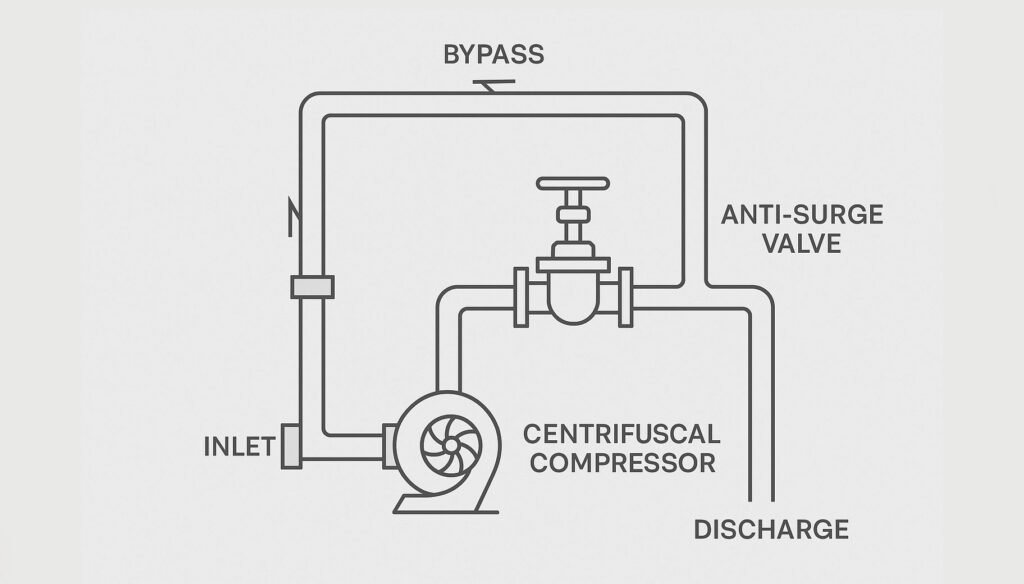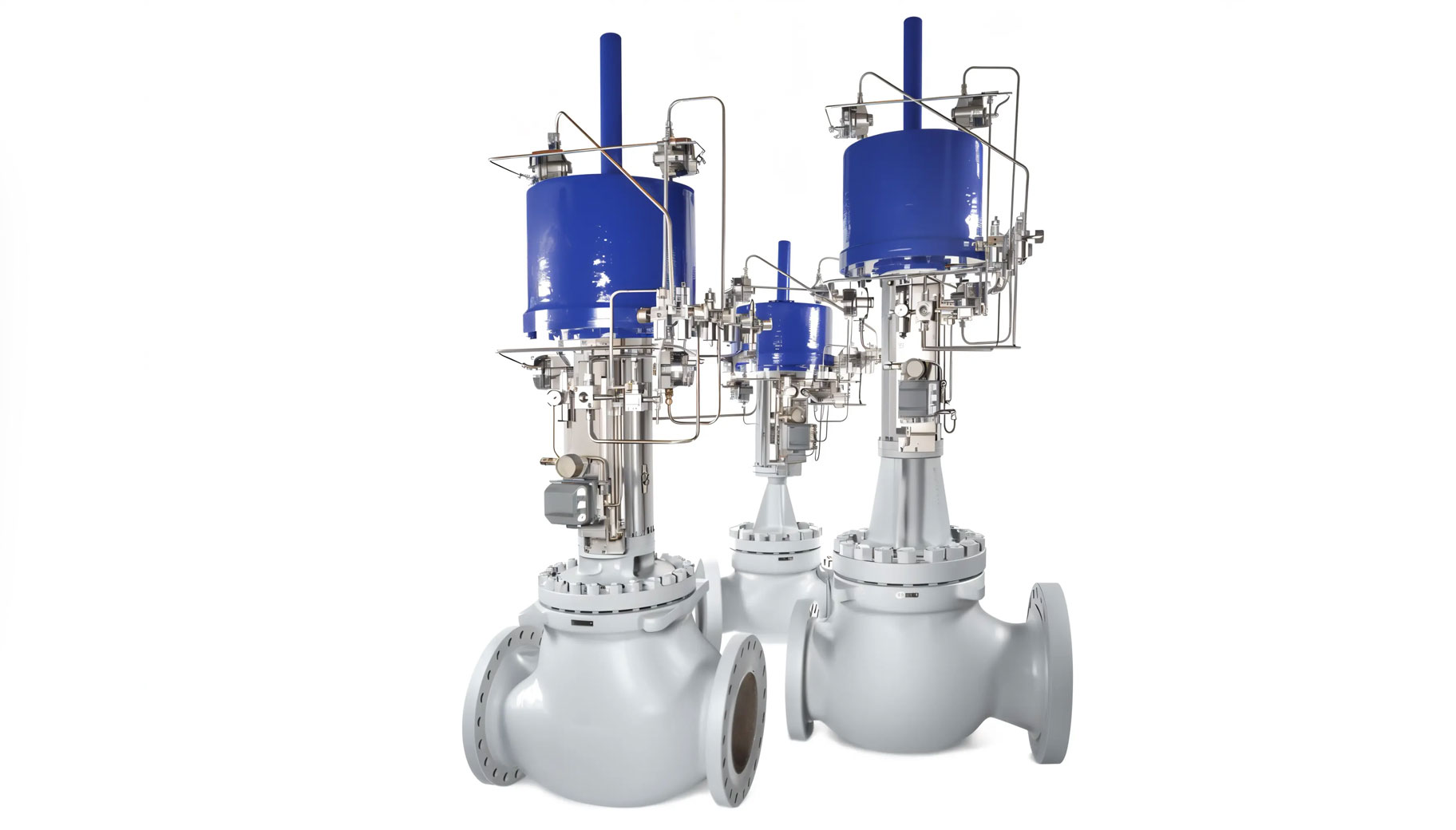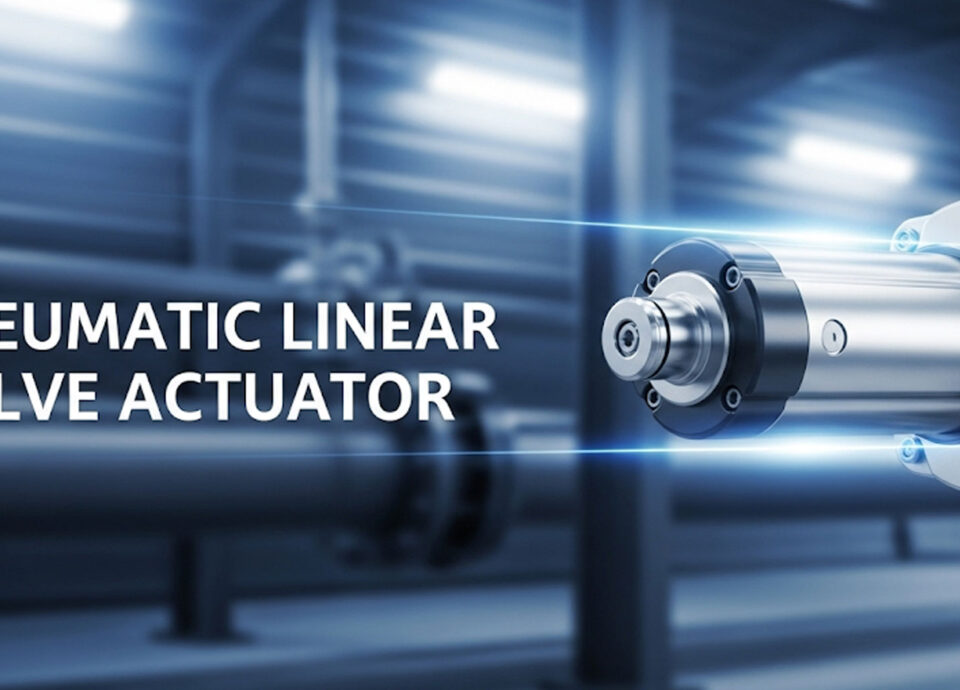Have you ever wondered what keeps massive industrial compressors from tearing themselves apart? It’s often a sophisticated, lightning-fast component known as an anti-surge valve. This vital piece of equipment is designed to prevent a phenomenon called “surge,” a highly destructive instability that can halt operations and cause millions in damage. Essentially, it’s the ultimate safety net for your compressor, ensuring smooth and uninterrupted operation and preventing compressor damage from surge.
What Exactly is an Anti-Surge Valve?
An anti-surge valve is a specialized, high-speed control valve engineered to protect dynamic compressors—like centrifugal and axial types—from a destructive condition known as surge. Imagine a high-powered fan pushing air into a closed room. If the room becomes too full, the air might try to flow backward through the fan. That’s a simplified view of surge, and for a compressor, it’s catastrophic. This valve acts as a rapid-response bypass, opening to relieve pressure and maintain a minimum flow through the compressor.
These valves are anything but standard. They are designed for extreme speed, often capable of stroking (moving from fully closed to fully open) in less than a second, according to industry standards for critical control valves [1]. This incredible speed is crucial because surge can develop and inflict serious damage almost instantaneously. Typically installed in a recycle line that connects the compressor’s discharge back to its suction, the valve remains closed during normal operation, ready to spring into action at a moment’s notice. Understanding how anti-surge valves work is key to appreciating their role in complex systems.
Have you ever wondered what keeps massive industrial compressors from tearing themselves apart? It’s often a sophisticated, lightning-fast component known as an anti-surge valve. This vital piece of equipment is designed to prevent a phenomenon called “surge,” a highly destructive instability that can halt operations and cause millions in damage. Essentially, it’s the ultimate safety net for your compressor, ensuring smooth and uninterrupted operation and preventing compressor damage from surge.
What is the Critical Function of an Anti-Surge Valve?

The fundamental function of an anti-surge valve is to prevent compressor surge. Surge occurs when the flow rate of gas through a compressor drops below a critical minimum while it’s still trying to maintain a high high discharge pressure. When the downstream pressure overcomes the compressor’s ability to generate forward flow, the gas momentarily reverses direction. This creates a violent, cyclical event characterized by rapid pressure swings, strong vibrations, and a distinctive “whooshing” or “banging” sound. The Gas Processors Suppliers Association (GPSA) Engineering Data Book provides detailed charts illustrating these unstable regions on compressor performance maps [2].
To combat this, the anti-surge valve provides a controlled bypass path for the gas. When the compressor’s operating conditions drift too close to the surge line—the operational boundary between stable and unstable flow—the anti-surge control system rapidly signals the valve to open. By diverting a portion of the compressed gas from the discharge back to the suction, the valve effectively increases the flow through the compressor, pushing its operating point back into a safe, stable region. This immediate recirculation is paramount for the compressor’s survival. Without this rapid intervention, the forces generated during surge can warp impellers, shatter bearings, and damage seals, leading to costly and lengthy shutdowns. This process is essential for compressor anti-surge protection.
What is the Primary Purpose of an Anti-Surge Valve?

The main purpose of an anti-surge valve is to ensure asset protection, operational reliability, and personnel safety. Compressors are often the heart of industrial operations, representing substantial investments, sometimes costing millions of dollars. The implications of a surge event extend far beyond just mechanical damage:
- Preventing Catastrophic Equipment Failure: The valve protects critical components like impellers, shafts, and bearings from destructive forces. Industry reports often cite mechanical damage from surge as a leading cause of unscheduled compressor downtime [3]. This also includes safeguarding the anti-surge valve control system itself from feedback damage.
- Ensuring Operational Continuity: By preventing shutdowns caused by surge, it maintains consistent production and avoids costly downtime. Losing even an hour of production in some plants can translate to hundreds of thousands of dollars.
- Enhancing Safety: The violent vibrations and potential for component disintegration during surge pose significant risks to plant personnel and surrounding infrastructure. This is why anti-surge valve operation is so critical for overall plant safety.
Essentially, the anti-surge valve acts as a high-tech insurance policy, safeguarding crucial equipment and ensuring that complex industrial processes run without interruption. It’s a silent guardian, always vigilant.
Anti-Surge Control Valve: More Than Just an On/Off Switch
The term “anti-surge control valve” is commonly used interchangeably with anti-surge valve, but it highlights a crucial distinction: these are not simple isolation valves. They are highly responsive, modulating devices that are an integral part of an sophisticated control loop. For those seeking to understand anti-surge valve types, distinguishing this capability is important.
What sets an anti-surge control valve apart from a standard process control valve?
| Feature | Anti-Surge Control Valve | Standard Process Control Valve |
|---|---|---|
| Response Speed | Extremely fast (e.g., <1 second full stroke) | Typically slower (several seconds) |
| Actuation Power | High-thrust, quick-response actuators (often pneumatic with volume boosters) | Standard actuators, less emphasis on speed |
| Flow Capacity | Designed for high bypass flow rates | Sized for specific process flow modulation |
| Fail-Safe | Usually “fail-open” to protect compressor | Varies (fail-closed, fail-open, fail-last) |
| Durability | Robust for rapid, repetitive cycling | Designed for continuous, steady operation |
This table clarifies that while both are “control valves,” the anti-surge variant is a precision instrument engineered for a very specific, high-stakes role. For example, a typical 10-inch anti-surge valve might require an actuator capable of delivering over 10,000 lbs of thrust to ensure rapid closure against high differential pressures, something a standard valve wouldn’t need. Its internal “trim” (the plug and seat that regulate flow) is often designed to handle high-velocity gas and prevent cavitation [the formation and collapse of vapor bubbles] or choked flow [flow restricted by the speed of sound]. This makes them very different from a standard bypass valve.
Understanding Control Valve Hunting: A Technical Dive
Even the best-designed control valves, including anti-surge valves, can experience issues. One common problem is “hunting,” where the valve continuously over-adjusts around its setpoint, causing instability in the process. This is a critical concern because a hunting anti-surge valve cannot provide reliable protection.
Common Causes of Control Valve Hunting: Engineers frequently encounter control valve hunting across industrial plants. This abnormal operation often manifests as a mismatch between the command signal and the valve’s actual feedback. Identified causes typically include:
- Valve body sticking: Internal friction or debris can prevent smooth movement.
- Actuator passing issues: Problems within the actuator (the device that moves the valve) itself, such as leaking diaphragms or worn seals, can lead to imprecise positioning.
- Low air pressure: Insufficient instrument air supply, often due to faulty air filter regulators, can cripple an actuator’s performance.
- Leaks or chokes in instrument air tubes: Even small leaks or blockages in the pneumatic lines can cause erratic control.
The Fault Tree Analysis Approach: When faced with hunting, instrument engineers often turn to systematic troubleshooting methods like Fault Tree Analysis (FTA). This technique involves mapping out all possible causes in a diagram, starting from the undesired event (valve hunting) and tracing back potential failures. This structured approach helps to quickly narrow down the problem.
For example, in a common scenario, engineers might bypass the valve positioner by supplying direct air to the actuator. If the valve then operates smoothly, it indicates that the valve body and actuator are likely functioning correctly, pointing the finger at the positioner. Further inspection often reveals the positioner’s output air is fluctuating, confirming a faulty positioner as the root cause. This quick check can save significant time and cost in diagnosing the issue. Maintaining anti-surge valve positioner calibration is therefore critical.
This systematic troubleshooting approach is a key learning for any engineer working with complex control systems. Simple checks can lead to efficient and effective fixes, crucial for maintaining optimal anti-surge valve performance.
The Anti-Surge Valve’s Indispensable Role in Compressor Systems
Within complex compressor systems, the anti-surge valve is never an isolated component. It operates in perfect synchronicity with a dedicated anti-surge controller—a sophisticated electronic brain, often a high-speed PLC (Programmable Logic Controller) or a dedicated module within a DCS (Distributed Control System).
This controller constantly monitors a range of critical operating parameters:
- Suction and Discharge Pressures: Providing insights into the pressure differential across the compressor.
- Suction and Discharge Temperatures: Affecting gas density and compressor performance.
- Gas Flow Rates: The most direct indicator of proximity to surge.
- Compressor Speed: Especially critical for variable-speed compressors.
Using these inputs, the controller calculates the compressor’s real-time operating point on its unique performance map. If this point drifts too close to the pre-programmed “control line” (a safety margin set slightly above the actual surge line), the controller immediately sends a rapid signal to the anti-surge valve. The valve then opens just enough to recycle the necessary amount of gas, shifting the operating point back into the stable region. This continuous feedback loop ensures the compressor stays within its safe limits without wasting excessive energy through unnecessary recycling. This is the core of anti-surge valve control logic.
Always ensure that your anti-surge control system is regularly calibrated and tested. A system that isn’t accurately measuring conditions or responding quickly enough is as good as no system at all. I’ve personally seen how a few degrees off on a temperature transmitter can subtly shift the calculated surge line, putting a compressor at risk. Many incidents can be traced back to poor instrument calibration, highlighting the need for reliable anti-surge valve maintenance.
Do Marine Anti-Surge Valves Help Prevent Reversion? A Critical Clarification
This is a common point of confusion, and it’s important to clarify. An anti-surge valve is specifically designed to protect dynamic compressors from flow instabilities within their impellers.
The term “reversion” in a marine context typically refers to exhaust gas reversion in reciprocating internal combustion engines. This phenomenon occurs when exhaust gases flow backward into the engine cylinders during the valve overlap period (when both intake and exhaust valves are briefly open). This can contaminate the fresh intake charge, reduce engine power, and even damage components over time, as described in automotive and marine engine design principles [4]. This is a very different issue from compressor surge prevention.
Therefore, no, a marine anti-surge valve (in the context of compressor protection) does not help prevent exhaust gas reversion in a marine engine. These are completely distinct engineering problems. While marine vessels certainly employ compressors (e.g., for air conditioning, cargo refrigeration, or LNG regasification), and these compressors would indeed have anti-surge valves, this is separate from the engine’s exhaust system. Preventing exhaust reversion typically involves careful exhaust manifold design, camshaft profiling, and sometimes specialized anti-reversion headers. It’s a classic example of how similar-sounding issues require completely different solutions!
The Anti-Surge Valve’s Indispensable Role in Compressor Systems
Within complex compressor systems, the anti-surge valve is never an isolated component. It operates in perfect synchronicity with a dedicated anti-surge controller—a sophisticated electronic brain, often a high-speed PLC (Programmable Logic Controller) or a dedicated module within a DCS (Distributed Control System).
This controller constantly monitors a range of critical operating parameters:
- Suction and Discharge Pressures: Providing insights into the pressure differential across the compressor.
- Suction and Discharge Temperatures: Affecting gas density and compressor performance.
- Gas Flow Rates: The most direct indicator of proximity to surge.
- Compressor Speed: Especially critical for variable-speed compressors.
Using these inputs, the controller calculates the compressor’s real-time operating point on its unique performance map. If this point drifts too close to the pre-programmed “control line” (a safety margin set slightly above the actual surge line), the controller immediately sends a rapid signal to the anti-surge valve. The valve then opens just enough to recycle the necessary amount of gas, shifting the operating point back into the stable region. This continuous feedback loop ensures the compressor stays within its safe limits without wasting excessive energy through unnecessary recycling. This is the core of anti-surge valve control logic.
- Practical Tip: Always ensure that your anti-surge control system is regularly calibrated and tested. A system that isn’t accurately measuring conditions or responding quickly enough is as good as no system at all. I’ve personally seen how a few degrees off on a temperature transmitter can subtly shift the calculated surge line, putting a compressor at risk. Many incidents can be traced back to poor instrument calibration, highlighting the need for reliable anti-surge valve maintenance.
What Happens If an Anti-Surge Valve System is Ignored? A Dire Warning!
Ignoring or neglecting your anti-surge valve system is akin to driving a car without brakes. The consequences can be catastrophic. Without a functional anti-surge system, a compressor facing low flow conditions will go into surge. This can lead to:
- Immediate Mechanical Destruction: Impellers can shatter, bearings seize, and shafts bend. The high-energy vibrations can cause structural damage to the compressor casing itself.
- Explosion Risk: In processes involving flammable gases, the mechanical failure and high temperatures generated during surge can create ignition sources, leading to fires or explosions. This is a severe safety concern with compressors.
- Total Plant Shutdown: A major compressor failure will almost certainly bring down the entire process line it supports, leading to massive production losses and extended repair periods. The financial impact can quickly escalate into millions of dollars.
- Environmental Release: Damaged seals during surge can lead to the uncontrolled release of process gases, which could be toxic, flammable, or harmful to the environment, resulting in significant regulatory penalties.
The cost of proper maintenance and timely replacement of anti-surge components pales in comparison to the immense financial, safety, and environmental liabilities of a surge-induced failure. Understanding anti-surge valve troubleshooting is also vital for rapid response.
Key Takeaway: Prioritize Your Anti-Surge Valve’s Health
The anti-surge valve is an indispensable component in any dynamic compressor system. Its ability to react rapidly and precisely to prevent surge protects valuable assets, ensures operational continuity, and safeguards personnel. Never underestimate its importance. Regular inspection, maintenance, and calibration of the entire anti-surge control loop are not just good practices—they are absolutely essential for safe and reliable operations.
References:
[1] International Society of Automation (ISA). Standards and Practices for Control Valves. [Accessed via general knowledge of ISA standards] [2] Gas Processors Suppliers Association (GPSA). Engineering Data Book. [Accessed via general knowledge of GPSA publications] [3] Turbomachinery International Magazine. Various articles on compressor reliability and failure analysis. [Accessed via general knowledge of industry publications] [4] Society of Automotive Engineers (SAE). Technical Papers on Internal Combustion Engine Design and Exhaust Systems. [Accessed via general knowledge of SAE publications]




